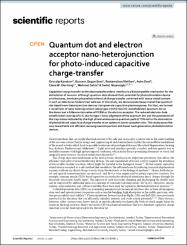| dc.contributor.author | Karatum, Onuralp | |
| dc.contributor.author | Eren, Guncem Ozgun | |
| dc.contributor.author | Melikov, Rustamzhon | |
| dc.contributor.author | Onal, Asim | |
| dc.contributor.author | Ow-Yang, Cleva W. | |
| dc.contributor.author | Sahin, Mehmet | |
| dc.date.accessioned | 2022-02-18T06:35:07Z | |
| dc.date.available | 2022-02-18T06:35:07Z | |
| dc.date.issued | 2021 | en_US |
| dc.identifier.issn | 2045-2322 | |
| dc.identifier.other | PubMed ID33510322 | |
| dc.identifier.uri | https //doi.org/10.1038/s41598-021-82081-y | |
| dc.identifier.uri | https://hdl.handle.net/20.500.12573/1166 | |
| dc.description | This work is supported by European Research Council (ERC) European Union Horizon 2020 (639846). The authors sincerely thank Koc University Boron and Advanced Materials Application and Research Center (KABAM) and Koc University Surface Science and Technology Center (KUYTAM) for the use of the facilities. We gratefully acknowledge the Center Research Laboratory at the University of Bayburt for TEM analysis. | en_US |
| dc.description.abstract | Capacitive charge transfer at the electrode/electrolyte interface is a biocompatible mechanism for the stimulation of neurons. Although quantum dots showed their potential for photostimulation device architectures, dominant photoelectrochemical charge transfer combined with heavy-metal content in such architectures hinders their safe use. In this study, we demonstrate heavy-metal-free quantum dot-based nano-heterojunction devices that generate capacitive photoresponse. For that, we formed a novel form of nano-heterojunctions using type-II InP/ZnO/ZnS core/shell/shell quantum dot as the donor and a fullerene derivative of PCBM as the electron acceptor. The reduced electron-hole wavefunction overlap of 0.52 due to type-II band alignment of the quantum dot and the passivation of the trap states indicated by the high photoluminescence quantum yield of 70% led to the domination of photoinduced capacitive charge transfer at an optimum donor-acceptor ratio. This study paves the way toward safe and efficient nanoengineered quantum dot-based next-generation photostimulation devices. | en_US |
| dc.description.sponsorship | European Research Council (ERC) 639846 | en_US |
| dc.language.iso | eng | en_US |
| dc.publisher | NATURE RESEARCHHEIDELBERGER PLATZ 3, BERLIN 14197, GERMANY | en_US |
| dc.relation.isversionof | 10.1038/s41598-021-82081-y | en_US |
| dc.rights | info:eu-repo/semantics/openAccess | en_US |
| dc.title | Quantum dot and electron acceptor nano-heterojunction for photo-induced capacitive charge-transfer | en_US |
| dc.type | article | en_US |
| dc.contributor.department | AGÜ, Mühendislik Fakültesi, Malzeme Bilimi ve Nanoteknoloji Mühendisliği Bölümü | en_US |
| dc.contributor.institutionauthor | Nizamoglu, Sedat | |
| dc.identifier.volume | Volume 11 Issue 1 | en_US |
| dc.relation.journal | SCIENTIFIC REPORTS | en_US |
| dc.relation.publicationcategory | Makale - Uluslararası - Editör Denetimli Dergi | en_US |


















